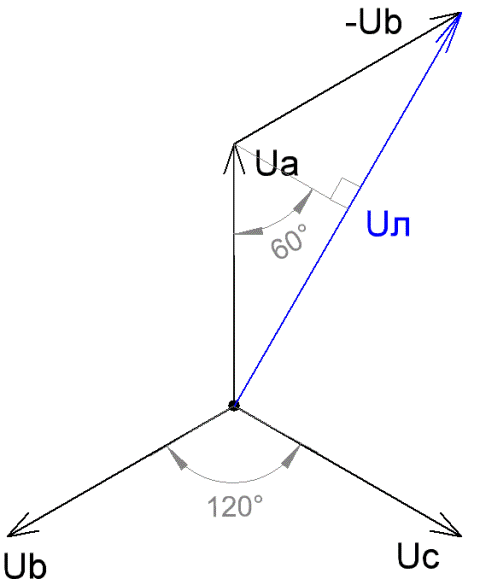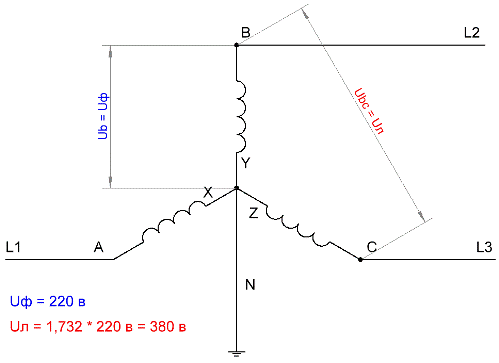Line and Phase Voltage — Difference and Ratio
In this short article, without going into the history of alternating current networks, we will understand the relationship between phase and line voltage. We will answer the questions of what is phase voltage and what is line voltage, how are they related to each other and why these relationships are exactly the same.
It is no secret that today electricity from generating power plants is delivered to consumers via high voltage power lines with a frequency of 50 Hz. In transformer substations, the high sinusoidal voltage is reduced and distributed to consumers at 220 or 380 volts. Somewhere the network is single-phase, somewhere three-phase, but let's figure it out.

RMS and peak voltage
First of all, we note that when they say 220 or 380 volts, they mean the effective values of the voltages, from a mathematical point of view - rms voltages... What does it mean?
This means that actually the amplitude Um (maximum) of the sinusoidal voltage, phase Umph or linear Uml, is always greater than this effective value.For a sinusoidal voltage, its amplitude is greater than the effective value with the root 2 times, that is, 1.414 times.
So for a phase voltage of 220 volts, the amplitude is 310 volts, and for a line voltage of 380 volts, the amplitude will be 537 volts. And if we take into account that the voltage in the network is never stable, then these values can be either lower or higher. This circumstance must always be taken into account, for example, when choosing capacitors for a three-phase asynchronous motor.
Phase line voltage
The generator windings are connected and connected with the X, Y and Z ends at one point (at the center of the star) which is called the neutral or zero point of the generator. This is a four-wire, three-phase circuit. The line conductors L1, L2 and L3 are connected to the terminals of the coils A, B and C, and the neutral conductor N is connected to the neutral point.
The voltages between terminal A and zero point, B and zero point, C and zero point, are called phase voltages, they are denoted by Ua, Ub and Uc, but since the network is symmetrical, you can simply write Uph — phase voltage .
In three-phase alternating current networks in most countries, the standard phase voltage is approximately 220 volts - the voltage between the phase conductor and the neutral point, which is usually earthed, and its potential is assumed to be zero, which is why it is also called neutral point.
Line voltage of a three-phase network
The voltages between terminal A and terminal B, between terminal B and terminal C, between terminal C and terminal A are called line voltages, that is, they are the voltages between the line conductors of a three-phase network. They are labeled as Uab, Ubc, Uca or you can simply write Ul.
The standard mains voltage in most countries is approximately 380 volts.In this case it is easy to see that 380 is 1.727 times greater than 220 and, neglecting losses, it is clear that this is the square root of 3, that is 1.732. Of course, the network voltage all the time in one direction or another fluctuates depending on the current network load, but the relationship between the line and phase voltages is exactly the same.
Where did the root of 3 come from?
The vector image method is often used in electrical engineering. sinusoidally time-varying voltages and currents.
The graph of the dependence of the magnitude of the projection on time is a sinusoid. And if the amplitude of the voltage is the length of the vector U, then the projection that changes with time is the current value of the voltage, and the sinusoid reflects the dynamics of the voltage.

So, if we now draw a vector diagram of three-phase voltages, it turns out that there are equal angles of 120 ° between the vectors of the three phases, and then if the lengths of the vector are the effective values \u200b\u200bof the phase voltages Uph, then to find the line voltages Ul, it is necessary to calculate the DIFFERENCE of each pair of vectors with two phase voltages. For example, Ua — Ub.

Having completed the construction by the parallelogram method, we will see that the vector Ul = Ua + (-Ub) and as a result Ul = 1.732Uf. From here it turns out that if the standard phase voltages are 220 volts, the corresponding linear ones will be equal to 380 volts.

